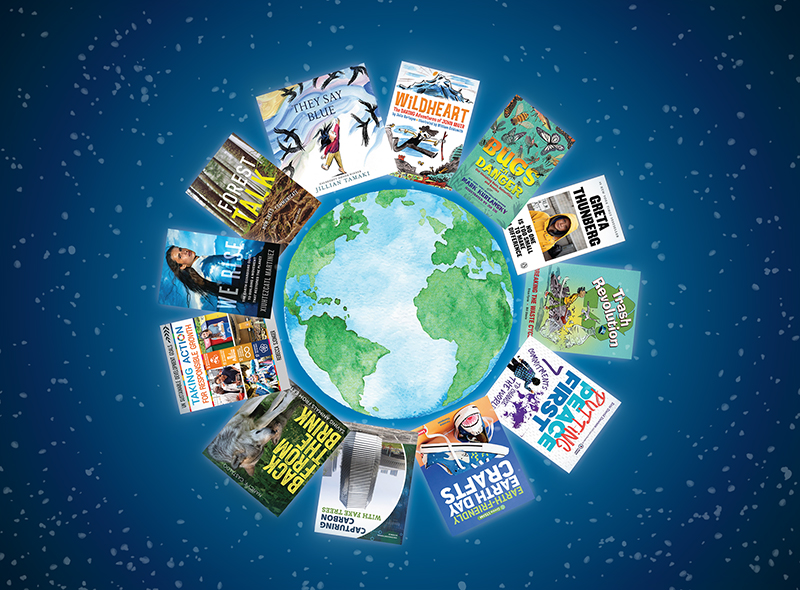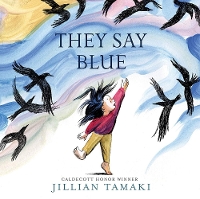12 Nonfiction Books To Commemorate Earth Day
Celebrate the 50th anniversary of Earth Day with these 12 nonfiction books for elementary, middle school, and high school readers.

This April is the 50th anniversary of Earth Day. The origins of this annual event can be traced back to Gaylord Nelson, a Democratic U.S. senator and former governor from Wisconsin. Nelson called for a national “teach-in” about the environment, in part a response to a huge oil spill a year earlier in Santa Barbara, CA, that killed thousands of birds.
Today, Earth Day is celebrated in over 190 countries and is estimated to mobilize a billion people to take action on ecological issues. With global climate change at the front of the political agenda and teen activist Greta Thunberg nominated for the Nobel Peace Prize for the second year in a row, interest in environmental action and activism is soaring.
The books listed cover a range of approaches to science, art, political action, and everyday life choices, but share a commitment to reverse the damage being done to Earth and to make it a healthier place for all its creatures.
Elementary
 Tamaki, Jillian. They Say Blue. illus. by Jillian Tamaki. Abrams. Mar. 2018. ISBN 9781419728518.
Tamaki, Jillian. They Say Blue. illus. by Jillian Tamaki. Abrams. Mar. 2018. ISBN 9781419728518.
PreS-Gr 1–Tamaki’s gorgeously rendered meditation on the seasons follows an unnamed narrator watching the blue sky and sea from a grassy beach. She stretches her fingers and sprouts into a living tree, then listens quietly to the sounds of the world around her. When winter arrives, she can’t tell the difference between land and sky. An insightful primer that contemplates the relationship between nature and the human world and the role of humans in the natural world.

Thompson, Veronica. Earth-Friendly Earth Day Crafts. Lerner. Aug. 2019. ISBN 9781541524200.
Gr 2-5–Some of the crafts in this book are ecologically inclined, such as a “townhome” for bees made from plastic straws and a repurposed box or storage tub, or planters made from recycled glass jars and decorated with marbled nail polish. Other projects encourage keeping discarded trash out of the waste stream. For example, craft paper is made from pulping old homework and junk mail. An “Odds & Ends” section offers quick suggestions for repurposing everyday garbage. A fun introduction to recycling.
Middle School
 Castaldo, Nancy F. Back from the Brink: Saving Animals from Extinction. HMH. Apr. 2018. ISBN 9780544953437.
Castaldo, Nancy F. Back from the Brink: Saving Animals from Extinction. HMH. Apr. 2018. ISBN 9780544953437.
Gr 5–7—After an introduction outlining the challenges of fending off species extinction in the wild and celebrating conservationists from previous generations, Castaldo describes recent successes recovering stable populations of the whooping crane, gray wolf, bald eagle, Galápagos tortoise, California condor, and American alligator and bison. The book features lush photos and intriguing sidebars, including some of the text of the Endangered Species Act and an account by author Herman Melville of his visit to the Galápagos Islands. A substantial list of video and print resources is provided, as well as contact info for conservation organizations and wildlife habitats.

Fyvie, Erica. Trash Revolution: Breaking the Waste Cycle. illus. by Bill Slavin. Kids Can. Apr. 2018. ISBN 9781771380782.
Gr 3–6—This accessible, informative, and fun book examines what people throw away, how common materials are produced, and the impact of trash on the world. Most chapters begin by considering an item likely to be in a student’s backpack—a water bottle, gym clothes, paper, a cell phone—and use it to explore aspects of the waste cycle. Many alternative technologies are examined, including plastic made from pig urine and fabric from kombucha bacteria. Slavin’s cartoon drawings clearly illustrate industrial processes and scientific principles. An extensive list of websites and books offers more information.
 Koch, Melissa. Forest Talk: How Trees Communicate. Lerner/Twenty-First Century. Jan. 2019. 9781541519770.
Koch, Melissa. Forest Talk: How Trees Communicate. Lerner/Twenty-First Century. Jan. 2019. 9781541519770.
Gr 4–8—Everything in a forest is connected. Trees share information in ways scientists are only beginning to understand. Koch includes profiles of several scientists working in forest ecology. Nalini Nadkarni of the University of Utah is noted for her research in energy and nutrient exchange and in organizing Earth-friendly work with prison inmates in Washington State. A chapter that features a profile of 2004 Nobel Peace Prize Laureate Wangari Maathai offers numerous suggestions to take action helping forests and trees.

Kurlansky, Mark. Bugs in Danger: Our Vanishing Bees, Butterflies, and Beetles. illus. by Jia Liu. Bloomsbury. Nov. 2019. ISBN 9781547600854.
Gr 5-8–Honeybees, monarch butterflies, and ladybugs are among the most visible North American insects; but as pollinators, they are also responsible for the future of many angiosperms (flowering plants) important to humans, including apples, almonds, and cotton. Along with a number of other insect species, they’re increasingly under threat. The text explains the damage done to insects through human activity, largely habitat loss and overuse of pesticides. A concluding chapter outlines specific actions readers can take to help stop the damage, such as planting gardens to attract pollinators.
Read: Games Can Teach About Climate Change and Motivate Ecofriendly Actions
 McCarthy, Cecilia Pinto. Capturing Carbon with Fake Trees. Abdo. Aug. 2019. ISBN 9781532118968.
McCarthy, Cecilia Pinto. Capturing Carbon with Fake Trees. Abdo. Aug. 2019. ISBN 9781532118968.
Gr 4-6–Physicist and engineer Klaus Lackner got the idea for developing materials to absorb carbon from the atmosphere from his daughter’s middle school science project. But Lackner’s technology is only one of many outlined here. The text is packed with pertinent photos as well as infographics, such as an illustration of the carbon cycle and a graph showing the increase in atmospheric carbon dioxide over the last half-century. The short and simple sentences will appeal to younger or reluctant readers. A brief bibliography and a curated list of online resources are included. Should attract young activists with an interest in science.

Sjonger, Rebecca. Taking Action To Help the Environment. Crabtree. Sept. 2019. ISBN 9780778766605.
Gr 4-8–Four of the United Nations’ sustainable development goals are examined here, including climate action and clean energy. Colorful and dynamic photos feature activists and scientists working to mitigate the damage done to the Earth's ecosystem. Brief “Youth for Change” profiles highlight environmental action organizations founded by children. “Think Deep” sidebars encourage readers to contemplate, for example, how they could contact leaders about the kind of world they want to live in. A promising view of local action tied to global goals.
Middle and High School
 Dawson, Eric David. Putting Peace First: 7 Commitments To Change the World. Viking. Aug. 2018. ISBN 9781101997338.
Dawson, Eric David. Putting Peace First: 7 Commitments To Change the World. Viking. Aug. 2018. ISBN 9781101997338.
Gr 5–8—While Dawson’s book is not explicitly about climate action, it is a powerful introduction to peace work and effecting social change with nonviolence. The commitments of the title are basic principles such as “work with my enemies” and “keep trying.” Dawson, CEO of Peace First, an activism support organization he helped found when he was 18, features profiles of young leaders. Numerous inspirational quotations and personal narratives are included.

Martinez, Xiuhtezcatl. We Rise: The Earth Guardians Guide to Building a Movement that Restores the Planet. Rodale. Sept. 2017. 9781635650679.
Gr 7 Up—Part memoir, part activism manual, this book connects an impressive range of ecological issues to Martinez’s Indigenous Mexica roots and the stipulation that all life is sacred. The narrative is woven with interviews of environmental activists, including author and environmentalist Bill McKibben and former environmental advisor to President Obama Van Jones. A source notes section cites useful links to news articles, videos, and other resources. The 19-year-old author is the youth director of Earth Guardians, an international conservation group originally founded as a high school in Maui by his mother and a hip-hop artist.
Graphic Novels
 Bertagna, Julie. Wildheart: The Daring Adventures of John Muir. illus. by William Goldsmith. Yosemite Conservancy. Mar. 2019. 9781930238947.
Bertagna, Julie. Wildheart: The Daring Adventures of John Muir. illus. by William Goldsmith. Yosemite Conservancy. Mar. 2019. 9781930238947.
Gr 4–8—Naturalist, philosopher, early wilderness activist, and Sierra Club founder John Muir is a towering figure in American environmental history. Muir’s life is written as a first-person adventure. The text covers his childhood in Scotland to farm work in Wisconsin, his walk from Kentucky to Florida, his encounter with the Sierra Nevada range, and camping with President Theodore Roosevelt at Glacier Point in the Yosemite Valley. Goldsmith’s brisk, cartoonish style can go wide of capturing the natural splendor Muir is describing but will provide an accessible entry point for younger readers. A “Sources of Inspiration” section provides specific citations for passages quoted from Muir’s voluminous writings.
Adult Books for Teens
 Thunberg, Greta. No One is Too Small To Make a Difference. Penguin. Nov. 2019. 9780143133568.
Thunberg, Greta. No One is Too Small To Make a Difference. Penguin. Nov. 2019. 9780143133568.
Gr 6 Up—Arguably no activist is more visible, in the media and around the world, than 17-year-old Swedish #climatestrike advocate Greta Thunberg. This book is a collection of 16 speeches she delivered over one year, from a 2018 march in Stockholm to her address before the UN General Assembly and a Montreal rally in September 2019. Thunberg has called her Asperger’s syndrome a “superpower” and her communication style can be stark and direct. She is a skilled motivator and passionate advocate, a major inspiration for teens and tweens. A Spanish edition was published as Cambiemos el mundo.
Reviewed by Bob Hassett, Luther Jackson Middle School, Fairfax County, VA
RELATED
The job outlook in 2030: Librarians will be in demand
The job outlook in 2030: Librarians will be in demand
ALREADY A SUBSCRIBER? LOG IN
We are currently offering this content for free. Sign up now to activate your personal profile, where you can save articles for future viewing






Add Comment :-
Be the first reader to comment.
Comment Policy:
Comment should not be empty !!!